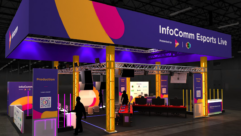

An InfoComm 2009 Wish List
InfoComm preview stories used to be a lot easier to write. Ten years ago, most AV manufacturers were all too happy to provide a detailed laundry list of new projectors, monitors, interfaces, and other goodies, sometimes as early as late March. But that’s all changed.
A couple of weeks ago, my hard-working editor sent me an e-mail asking that I try and focus my June column on all the new products and technologies that readers were likely to see at InfoComm 09 in Orlando. InfoComm preview stories used to be a lot easier to write. Ten years ago, most AV manufacturers were all too happy to provide me with a detailed laundry list of new projectors, monitors, interfaces, and other goodies, sometimes as early as late March. But that’s all changed.
Thanks to unrelenting downward pricing pressures and ever-shorter product life cycles, most companies don’t want to utter one peep until the day before the show opens, fearful that competitors will steal their thunder on product features and pricing. It’s rare that a display products manufacturer will even consent to let out advance product information under a non-disclosure agreement–that’s how tight information has become.
Credit: Pete Putman, CTS
Granted, not all manufacturers have zipped their lips. Some InfoComm products were actually unveiled at the NAB 2009 show in April, but those were spotted largely in the booths of audio/video interface manufacturers, such as Communications Specialties, Kramer, and Extron. By and large, display manufacturers have skipped NAB’s annual soiree, the exceptions being Sony, Panasonic, Barco, and Christie.
So after some thought, I decided to focus on industry trends and the products they’re likely to hatch.
If you’ve been paying close attention through the first decade of the 21st century, you already know that the communications industry is going digital–some sectors (broadcast, telecommunications, data) faster than others (pro AV). In fact, when it comes to embracing digital, our industry is pretty much dead last. The broadcast and cable/satellite guys are way ahead of us, as are the telecoms.
But it’s not for lack of effort on the part of AV designers and systems integrators. At April’s InfoComm 100 strategy meeting in Palm Beach, Fla., I had a chance to talk about this digital “foot-dragging” with a few dealers and integrators who consistently identified their clients’ reluctance to adopt digital, or lack of knowledge about it, as the major stumbling block to all-digital AV installations. (Apparently “going digital” is essentially a client education/re-education issue these days.)
With that in mind, let’s dust off the old crystal ball and make some fearless predictions about what should catch your eye in Orlando’s Orange County Convention Center.
Widescreen projection: Yep, we’ve been seeing this trend move in fits and starts over the past five years. But 2009 will be a big year for widescreen, perhaps generating enough momentum to finally get us unstuck from XGA (1024×768) as the norm for projection systems. And why not? Every new notebook computer comes with a 16:10 widescreen LCD display; flat-panel monitors are all widescreen now; and 99 percent of all new TV sets are widescreen.
Look for lots of WXGA (1280×800) LCD and DLP projectors, plus some more exotic WUXGA (1920×1200) models, to dominate manufacturer’s booths at the show. The WXGA format should do particularly well because it offers that all-too-important “backwards compatibility” that clients obsess over. Hey, whatever works.
HDMI switching and distribution: Funny thing about the High Definition Multimedia Interface: It was intended to be used on consumer products only. Lo and behold, it’s now starting to show up on professional-class monitors, as well as pro projectors. Since HDMI can do everything DVI can, takes up less room on an I/O panel, and adds digital audio transport capabilities, we’re going to see a steady move away from DVI connections. You’ll see even more interfaces with HDMI I/Os in Orlando, such as distribution amplifiers and seamless/presentation switchers.
Still not convinced? Upscaling DVD and Blu-ray players, plus cable, DBS, and IPTV set-top boxes have all migrated to HDMI digital interfaces. In most cases, that is the only connection that will provide 1080p video output to your system.
You’ll also find more “toolbox” interfaces for HDMI, including UTP and fiber-optic converters. Until DisplayPort gets off the ground–and that may take a few years–we’re stuck with HDMI, for better or worse.
Fiber optics: Speaking of fiber, look for a lot more of it at InfoComm 09. Bulk spools of optical fiber are priced the same as or less than Cat-5 cable, and it seems that each passing year brings new fiber-optic connectors that are faster and easier to attach than ever before.
Optical fiber is the only future-proof signal distribution system when it comes to handling increased demands for digital signal bandwidth–and you know those demands are only going to increase. In the good-old analog days, we obsessed over image resolutions and video signal formats. With digital, all we really care about is having enough bandwidth to move video, audio, and data through the facility, whatever the resolution or number of channels.
Advanced AV codecs: With the move to all-digital backbones comes the need for new AV codecs. Some of the NAB codec stalwarts like Tandberg and Harris are now showing up regularly at InfoComm.
The world is jumping all over MPEG-4 coding for everything from cable and satellite program distribution to IPTV systems. Digital media distribution systems rely on industry-standard codecs to acquire, store, playback, and forward content. Multiple MPEG programs can be combined into a “mux,” or digital data stream (there’s that bandwidth thing again) and switched simply by picking off the desired MPEG program numbers at the receiving end. If you don’t know much about codecs or how they work, set aside some time to visit these booths–you’ll be thanking me later.
Wireless interfaces: Wireless AV interfaces that can support high-definition TV were all the rage at CES 2009. There’s no reason to expect we won’t see the same products showing up at InfoComm–and not necessarily from the usual makers of wired products.
Implemented correctly, wireless AV backbones could simplify many retro installs. Wireless, all-in-one PDA/cell phone/media player gadgets will be the source of some client’s PowerPoint or video presentation in the not-too-distant future, so a plug-and-play wireless input to their AV system will be de rigueur. What these wireless interfaces will replace are the pop-up, desktop plug boxes we’re busy installing into conference room tables. No more fumbling with VGA cables and mini plugs for audio. The connection will be made using WiMax, or 802.11n, or some protocol we haven’t thought of yet.
Now, if I could just upgrade to an MPEG-4 crystal ball with WiMax inputs.
InfoComm 2008 Educator of the Year Pete Putman is a Pro AV contributing editor and president of ROAM Consulting in Doylestown, Pa.










